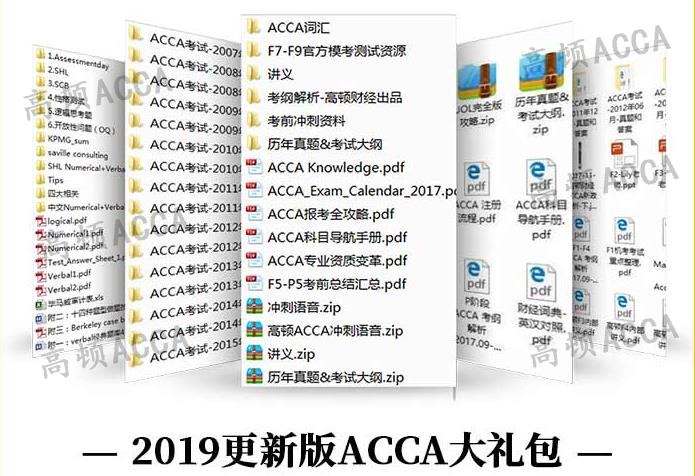acca f7考试内容是什么?F7考点解析
摘要:ACCA F7《财务报告》涵盖了财务会计、财务报表、公司合并报表、分析并解读财务报表等内容。F7《财务报告》是对F...
ACCA F7《财务报告》涵盖了财务会计、财务报表、公司合并报表、分析并解读财务报表等内容。F7《财务报告》是对F3《财务会计》的延伸,也是SBR的直接基础。通过学习F7,可以掌握如何运用会计准则和概念框架编制财务报表,分析并解读财务报表。为了帮助大家应对考试,高顿小编(zgacca)给大家整理一些ACCA F7考试技巧:
给大家推荐一个已经考过ACCA的高顿学姐,关于ACCA任何不懂的事情都可以咨询她。不仅能解决ACCA考试问题,还有电子版ACCA试题和ACCA备考资料(点击下图领取):微信ID:ACCAmengyue
Section A(每题2分,共15题,),sectionB(共3道长题,每题5小题,共15题)。
在四月考官见面会中,考官介绍说section B的题目是计算与文字混搭。每道大题中的五个小题相互不会有关联。考官甚至鼓励考生先做简单文字部分。
个人预计sectionB会根据以前的大准则题进行改编,比如:flight line,Telepath,Shawler等都是曾经比较经典题目。SectionA,B题目会覆盖整个syllabus,出镜可能比较高:
■environmental provision满足capitalizedas PPE/intangible,求期末相关总expense(即depreciation+interest expense);
■区分capital expenditure和revenue expenditure;
■capitalization of planned overhaul expense;
■repayment of government grant(两种方法下都必须掌握!);
■capitalization of borrowing costs onqualifying asset(注意capitalization开始的时点是三个条件全满足后,若相关工作暂停,capitalization必须暂停,完工时capitalization终止,和资产有没有被使用无关。interest income降低CV of asset必须发生在capitalization period);
■PPE和investment property互转(特别是PPE转成investmentproperty以公允价值计量);
■capitalization of development expense(重要考点!PIRATE满足前的expenses直接进入P/L,完工后开始计提amortization增加当期expense);
■计算recoverable value(higher of FVLCOS and value in use)to decide the amount of impairment;
■allocation of impairment in cash generatingunit(必会!);
■reclassification requirements for NCAs heldfor sale and the definition of discontinued operation;
■conceptual framework有可能考哪些treatments满足fair representation以及principle-based standard setting system的advantages;
■区分change in accounting policy(recognition,presentation andmeasurement)and change in accounting estimate;
■measurement of biological asset;
■assets outside the scope of IAS41;
■finance lease obligation table(withdeposit,both payment in advance and in arrears),straight line amortization ofoperating lease expense with premium or incentive;
■sale and finance lease back by using deferred income approach.
■Five steps of recognizing revenue(specially variable consideration,financing components and allocation of discount);
■revenue recognized over time;
■consignment sales(when the control of asset transferred to dealer);
■sale and repurchase(essence=secured loan);
■bill and hold arrangement;
■four steps of construction contract;
■calculation of exchange profit or loss on monetary items;
■EPS calculation under rights issue(注意rights issue bonus fraction的计算)and comparative EPS of previous year;
■under full market issue combined with bonus(注意bonus fraction计算);
■DEPs with convertible bond or share option(注意number offree shares的计算);
■financial liability measured at amortized cost;
■split of equity and debt elements of convertible bond(注意similar bond without conversion回报率一定会高);
■measurement of financial asset;
■factored receivable(如果坏账风险没有转移给保理人,则本质:secured loan);
■合并报表,现金流量表和报表解析也会出现在section a特别是special organization之ratio选择;
■Group's profit or loss on disposal of subsidiary应该会出现在六月考试中!
SectionC:如果是非合并报表就会搭配合并报表解析,反之亦然
准备非合并报表:考官在今年四月见面会中指出考调整retained earnings或者当期net profit的可能性比考整个损益表的可能性大,剩下SFP或者SOCIE则会考整表。其实无论哪种类型,和考完整报表编制思路一样的:先根据trial balance上余额列好相应报表格式,注意一表一页,行行留距!
F7报表考官基本以$'000为单位,workings也以此为计算单位。Standars adjustments包括:
depreciation on PPE,注意使用的方法。有时候会涉及revaluation of PPE,注意revaluation发生时点,是否需要transfer excess deprecation to retained earnings,以及revaluation gain是否增加当期deferred taxliability;
the calculation of income tax charge,注意trialbalance上如果current tax出现在debit side说明去年under provision了,需要增加今年tax expense.
其他常见调整项:convertible bond:发行第一年末之liability closing balance;
financial liability之issue cost调整,interest expense以及closing balance都可以很好利用amortized cot table应对。计算interest expense应该使用effective interest rate(即implicit interestrate);
如果是financial asset-debt instrument measured at FVTOCI也可以应用amortizedtable解决,interest income should be calculated假设如果以amortized cost进行计量下之interest income,FV movement can be reclassified into P/L on disposal,issue cost should be capitalized on initial recognition;
有时候还涉及对revenue和期末存货balance figure调整或者rights issue。这些调整项目相互独立,意味着如果你struggle with one adjustment,just move on to another one!
如果是编制合并报表,可能其中一张表是整表,另外一张报表就考某些accounting items在合并报表中的期末余额。基本调整项目包括:
deferred consideration,share for share exchange;
fair value adjustment of sub's net assets;
CV of goodwill at reporting date;
CV of NCI at reporting date;
group's reserve;
investment in associate;
intra-group trading:adjustment of unrealized profit,adjustment of intra-group interest,cash in transit,inventoryin transit(调整recipient账户),cancellation of current accounts between group members;
mid-year acquisition
报表解析:注意ratios计算,最多占4-5分,意味大家必须对公式十分熟悉!如果分析profitability一般从ROCE的变化入手,注意题目中除报表以外的文字信息,比如current year是否有新增或者出售子公司,如果有,可能会使得年度间ROCE不可比,特别是mid-year acquisition或者是disposal。记得ROCE=asset turnover*operating profit margin,所以进一步要观察asset turn over和operating profit margin的变化,别忘记无论收购还是出售子公司都可能发生significant amount of professional expenses但是they are one off in essence。
考官要求考生一定要能识别one off性质的gain or expense,比如redundancy costs,disposal profit on sub or NCAs,incremental expenses for bidding an important contract or promoting a new product。而且在收购当年不可能预计的benefits from expected synergy就能立即实现。如果企业把profitable的sub处置了,那director的动机是什么?是因为子母公司企业文化无法整合还是母公司有可能做了重大战略调整,准备转行,乘子公司还在盈利期将其出售卖个好价钱还是什么其他原因?在做liquidity分析前,先看看bank balance的变化,如果bank balance下降幅度比较大,分析一下原因,是收购新子公司?增购PPE?
观察R/Es的变化,可以得出cash dividends paid,结合公司资金分配,判断是否合理。所有和working capital efficiency相关ratios都有可能被:
收购,出售子公司
使用期末值
seasonal trading而扭曲。
Over trading是很多过于追求profit而不使用期限较长资金企业通病,如果不解决,进入财务困境可能极大。财务杠杆率要和行业或者竞争对手数据比较才有意义。如果一个企业处于business风险较高行业,其一般会保持低杠杆否则total risk太高。杠杆过高,企业可能会错过新的投资机会,因为现有债权人会impose strict covenants。总之,能够写的points其实很多,大家一定要最大化使用考官给到的extra information结合ratio变化作出解析!
给大家推荐一个已经考过ACCA的高顿学姐,关于ACCA任何不懂的事情都可以咨询她。不仅能解决ACCA考试问题,还有电子版ACCA试题和ACCA备考资料(点击下图领取):微信ID:ACCAmengyue
Section A(每题2分,共15题,),sectionB(共3道长题,每题5小题,共15题)。
在四月考官见面会中,考官介绍说section B的题目是计算与文字混搭。每道大题中的五个小题相互不会有关联。考官甚至鼓励考生先做简单文字部分。
个人预计sectionB会根据以前的大准则题进行改编,比如:flight line,Telepath,Shawler等都是曾经比较经典题目。SectionA,B题目会覆盖整个syllabus,出镜可能比较高:
■environmental provision满足capitalizedas PPE/intangible,求期末相关总expense(即depreciation+interest expense);
■区分capital expenditure和revenue expenditure;
■capitalization of planned overhaul expense;
■repayment of government grant(两种方法下都必须掌握!);
■capitalization of borrowing costs onqualifying asset(注意capitalization开始的时点是三个条件全满足后,若相关工作暂停,capitalization必须暂停,完工时capitalization终止,和资产有没有被使用无关。interest income降低CV of asset必须发生在capitalization period);
■PPE和investment property互转(特别是PPE转成investmentproperty以公允价值计量);
■capitalization of development expense(重要考点!PIRATE满足前的expenses直接进入P/L,完工后开始计提amortization增加当期expense);
■计算recoverable value(higher of FVLCOS and value in use)to decide the amount of impairment;
■allocation of impairment in cash generatingunit(必会!);
■reclassification requirements for NCAs heldfor sale and the definition of discontinued operation;
■conceptual framework有可能考哪些treatments满足fair representation以及principle-based standard setting system的advantages;
■区分change in accounting policy(recognition,presentation andmeasurement)and change in accounting estimate;
■measurement of biological asset;
■assets outside the scope of IAS41;
■finance lease obligation table(withdeposit,both payment in advance and in arrears),straight line amortization ofoperating lease expense with premium or incentive;
■sale and finance lease back by using deferred income approach.
■Five steps of recognizing revenue(specially variable consideration,financing components and allocation of discount);
■revenue recognized over time;
■consignment sales(when the control of asset transferred to dealer);
■sale and repurchase(essence=secured loan);
■bill and hold arrangement;
■four steps of construction contract;
■calculation of exchange profit or loss on monetary items;
■EPS calculation under rights issue(注意rights issue bonus fraction的计算)and comparative EPS of previous year;
■under full market issue combined with bonus(注意bonus fraction计算);
■DEPs with convertible bond or share option(注意number offree shares的计算);
■financial liability measured at amortized cost;
■split of equity and debt elements of convertible bond(注意similar bond without conversion回报率一定会高);
■measurement of financial asset;
■factored receivable(如果坏账风险没有转移给保理人,则本质:secured loan);
■合并报表,现金流量表和报表解析也会出现在section a特别是special organization之ratio选择;
■Group's profit or loss on disposal of subsidiary应该会出现在六月考试中!
SectionC:如果是非合并报表就会搭配合并报表解析,反之亦然
准备非合并报表:考官在今年四月见面会中指出考调整retained earnings或者当期net profit的可能性比考整个损益表的可能性大,剩下SFP或者SOCIE则会考整表。其实无论哪种类型,和考完整报表编制思路一样的:先根据trial balance上余额列好相应报表格式,注意一表一页,行行留距!
F7报表考官基本以$'000为单位,workings也以此为计算单位。Standars adjustments包括:
depreciation on PPE,注意使用的方法。有时候会涉及revaluation of PPE,注意revaluation发生时点,是否需要transfer excess deprecation to retained earnings,以及revaluation gain是否增加当期deferred taxliability;
the calculation of income tax charge,注意trialbalance上如果current tax出现在debit side说明去年under provision了,需要增加今年tax expense.
其他常见调整项:convertible bond:发行第一年末之liability closing balance;
financial liability之issue cost调整,interest expense以及closing balance都可以很好利用amortized cot table应对。计算interest expense应该使用effective interest rate(即implicit interestrate);
如果是financial asset-debt instrument measured at FVTOCI也可以应用amortizedtable解决,interest income should be calculated假设如果以amortized cost进行计量下之interest income,FV movement can be reclassified into P/L on disposal,issue cost should be capitalized on initial recognition;
有时候还涉及对revenue和期末存货balance figure调整或者rights issue。这些调整项目相互独立,意味着如果你struggle with one adjustment,just move on to another one!
如果是编制合并报表,可能其中一张表是整表,另外一张报表就考某些accounting items在合并报表中的期末余额。基本调整项目包括:
deferred consideration,share for share exchange;
fair value adjustment of sub's net assets;
CV of goodwill at reporting date;
CV of NCI at reporting date;
group's reserve;
investment in associate;
intra-group trading:adjustment of unrealized profit,adjustment of intra-group interest,cash in transit,inventoryin transit(调整recipient账户),cancellation of current accounts between group members;
mid-year acquisition
报表解析:注意ratios计算,最多占4-5分,意味大家必须对公式十分熟悉!如果分析profitability一般从ROCE的变化入手,注意题目中除报表以外的文字信息,比如current year是否有新增或者出售子公司,如果有,可能会使得年度间ROCE不可比,特别是mid-year acquisition或者是disposal。记得ROCE=asset turnover*operating profit margin,所以进一步要观察asset turn over和operating profit margin的变化,别忘记无论收购还是出售子公司都可能发生significant amount of professional expenses但是they are one off in essence。
考官要求考生一定要能识别one off性质的gain or expense,比如redundancy costs,disposal profit on sub or NCAs,incremental expenses for bidding an important contract or promoting a new product。而且在收购当年不可能预计的benefits from expected synergy就能立即实现。如果企业把profitable的sub处置了,那director的动机是什么?是因为子母公司企业文化无法整合还是母公司有可能做了重大战略调整,准备转行,乘子公司还在盈利期将其出售卖个好价钱还是什么其他原因?在做liquidity分析前,先看看bank balance的变化,如果bank balance下降幅度比较大,分析一下原因,是收购新子公司?增购PPE?
观察R/Es的变化,可以得出cash dividends paid,结合公司资金分配,判断是否合理。所有和working capital efficiency相关ratios都有可能被:
收购,出售子公司
使用期末值
seasonal trading而扭曲。
Over trading是很多过于追求profit而不使用期限较长资金企业通病,如果不解决,进入财务困境可能极大。财务杠杆率要和行业或者竞争对手数据比较才有意义。如果一个企业处于business风险较高行业,其一般会保持低杠杆否则total risk太高。杠杆过高,企业可能会错过新的投资机会,因为现有债权人会impose strict covenants。总之,能够写的points其实很多,大家一定要最大化使用考官给到的extra information结合ratio变化作出解析!



